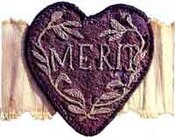
The Legion of Merit (LOM) is a military award of the United States Armed Forces that is given for exceptionally meritorious conduct in the performance of outstanding services and achievements. The decoration is issued to members of the eight uniformed services of the United States as well as to military and political figures of foreign governments.
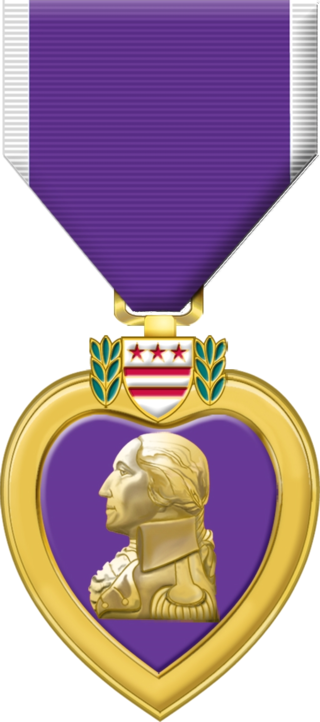
The Purple Heart (PH) is a United States military decoration awarded in the name of the president to those wounded or killed while serving, on or after 5 April 1917, with the U.S. military. With its forerunner, the Badge of Military Merit, which took the form of a heart made of purple cloth, the Purple Heart is the oldest military award still given to U.S. military members. The National Purple Heart Hall of Honor is located in New Windsor, New York.
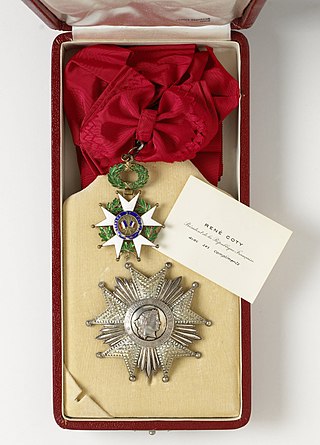
The National Order of the Legion of Honour, formerly the Royal Order of the Legion of Honour, is the highest French order of merit, both military and civil. Established in 1802 by Napoleon Bonaparte, it has been retained by all later French governments and regimes.

The Continental Army was the army of the United Colonies representing the Thirteen Colonies and later the United States during the American Revolutionary War. It was formed on June 14, 1775 by a resolution passed by the Second Continental Congress, meeting in Philadelphia after the war's outbreak. The Continental Army was created to coordinate military efforts of the colonies in the war against the British, who sought to maintain control over the American colonies. General George Washington was appointed commander-in-chief of the Continental Army and maintained this position throughout the war.
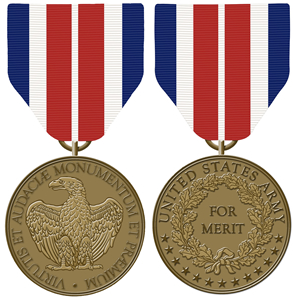
The Certificate of Merit Medal was a military decoration of the United States Army that was issued between the years of 1905 and 1918. The Certificate of Merit Medal replaced the much older Certificate of Merit which was authorized by the United States Congress on March 3, 1847.

Washington's Headquarters State Historic Site, also called Hasbrouck House, is located in Newburgh, New York, United States, overlooking the Hudson River. George Washington and his staff were headquartered in the house while commanding the Continental Army during the final year and a half of the American Revolutionary War; at 16 months and 19 days it was his longest tenure at any of his headquarters during the war.
Authorized foreign decorations of the United States military are those military decorations which have been approved for wear by members of the United States armed forces but whose awarding authority is the government of a country other than the United States.
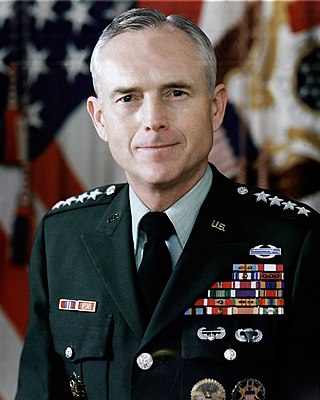
John Adams Wickham Jr. is a retired United States Army general who served as the United States Army Chief of Staff from 1983 to 1987.

William Brown (1759–1808) was a soldier for the Continental Army during the American Revolutionary War. He was born in Stamford and enlisted in the 5th Connecticut Regiment as a corporal on 23 May 1775, and re-enlisted as a private on 9 April 1777, for the duration of the war in the 8th Connecticut Regiment. He was promoted to corporal on 8 May 1779, and to sergeant on 1 August 1780, transferring with the consolidation of units to the 5th Connecticut Regiment on 1 January 1781, and to the 2nd Connecticut Regiment on 1 January 1783. He was awarded the Badge of Military Merit, one of only three people to be awarded the medal that later became the Purple Heart. No record of his citation has been uncovered, but it is believed that he participated in the assault on Redoubt No. 10 during the siege of Yorktown.

Daniel Bissell was a soldier and spy for the Continental Army during the American Revolutionary War. Bissell joined the British Army for 13 months and passed intelligence information to the Continental Army. For his efforts, Bissell was awarded the Badge of Military Merit by General George Washington.
The 2nd Continental Light Dragoons, also known as Sheldon's Horse after Colonel Elisha Sheldon, was commissioned by the Continental Congress on 12 December 1776, and was first mustered at Wethersfield, Connecticut, in March 1777 for service with the Continental Army. The regiment consisted of four troops from Connecticut, one troop each largely from Massachusetts and New Jersey, and two companies of light infantry.

The Massachusetts Line was those units within the Continental Army that were assigned to Massachusetts at various times by the Continental Congress during the American Revolutionary War. These, together with similar contingents from the other twelve states, formed the Continental Line. Line regiments were assigned to a particular state, which was then financially responsible for the maintenance of the regiment. The concept of the line was also particularly important in relation to the promotion of commissioned officers. Officers of the Continental Army below the rank of brigadier general were ordinarily ineligible for promotion except in the line of their own state.

The New Hampshire Line was a formation in the Continental Army. The term "New Hampshire Line" referred to the quota of numbered infantry regiments assigned to New Hampshire at various times by the Continental Congress. These, along with similar contingents from the other twelve states, formed the Continental Line. For the promotion of senior officials, this concept is particularly important. Officers of the Continental Army below the rank of brigadier general were ordinarily ineligible for promotion except in the line of their own state.

The National Purple Heart Hall of Honor is located along New York State Route 300 in the Town of New Windsor, New York, United States. It is less than two miles south of the Town of Newburgh line and not far from the City of Newburgh. It is a Purple Heart national registry of military personnel that have been injured or killed during combat. In 1782, at Washington's Headquarters State Historic Site, his headquarters in the City of Newburgh, George Washington created the Badge of Military Merit to be given to enlisted men and non-commissioned officers for meritorious action. The museum is located at the New Windsor Cantonment State Historic Site, the last encampment of the Continental Army. It is the first and currently only museum dedicated to a U.S. military medal.
Orders, decorations, and medals of the German Empire covers those decorations awarded by the states which came together under Prussian leadership to form the German Empire in 1871. For convenience's sake, this category also covers the decorations of the various German states which were no longer in existence in 1871, mainly because they had been annexed by Prussia during the Wars of Unification or before.

Colonel Russell Potter "Red" Reeder Jr. was a United States Army officer and writer.
Washington's aides-de-camp during the American Revolutionary War were officers of the Continental Army appointed to serve on General George Washington's headquarters staff, with the rank of lieutenant colonel. The headquarters staff also included one military secretary, a full colonel.
Events from the year 1782 in the United States

The Battle of Fort Slongo was fought on October 3, 1781 between American Continental Army forces, under the command of Benjamin Tallmadge and Lemuel Trescott, and the British defenders of Fort Salonga, in the American Revolutionary War. The fort was located near the border of present-day Huntington Township and Smithtown, New York, overlooking Long Island Sound.
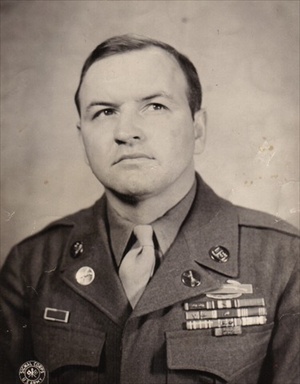
Llewellyn Morris Chilson was a United States Army master sergeant and one of the most decorated American soldiers of World War II. He received twelve individual decorations for combat from the U.S. Army including seven decorations for valor. After the war, the President of the United States personally decorated Chilson with seven decorations including three Distinguished Services Crosses for extraordinary heroism in Germany.
